by Aimee Kennedy, Battelle Vice-President of Education and STEM Learning
Two weeks ago, we read that many Ohio college students graduate tens of thousands of dollars in debt. Reporting on the Project on Student Debt’s latest analysis, the Dispatch’s Encarnita Pyle wrote:
Despite efforts by colleges to hold their costs down, Ohio students who borrowed money and earned a bachelor’s degree in 2012 graduated with an average of $29,037 in student-loan debt… Continued.
Unless those students are writing a check on the stage at graduation, it’s safe to assume that interest will push what they owe to well over $30,000. Thirty-thousand dollars is a lot of money to owe, especially before your career is even underway.
What’s the answer for a system that saddles Ohioans with that kind of debt? Pyle’s piece offers comments and ideas from representatives of colleges and higher-education policy makers.
Could colleges do more to reduce costs? Probably. It’s great to see Chancellor Carey and others are focused on the issue.
Is that the only option? No, it’s not.
Too many students are spending time in college catching up on things they could have (and should have) learned in high school. Too many Ohio students are leaving high school unprepared for college. Why? Put simply, most high schools plan for students to earn a minimum credential that doesn’t provide them entry into either career or college: the high school diploma.
When a student graduates high school, we expect them to be able to choose one of three paths: college, a job, or starting their own business. For many students, it seems clear that high school alone has only prepared them for a fourth option: none of the above. Today’s high school diploma just doesn’t mean what it used to.
Look at the volume of students who still needed remedial courses after graduating from high school and enrolling in college. The latest data from the Ohio Board of Regents says 40% of students at Ohio’s public colleges took remedial courses. How well prepared a student is when she walks on to a college campus matters. It impacts how much debt he’s going to rack up and, just as importantly, how likely she is to finish that degree.
We can do better. The track record of schools like Metro Early College prove that all students, including those who arrive with serious gaps, can graduate on track and ready for college.
 There are high schools that prepare student for what’s next. High schools where students get the internships, college classes, and independent learning they need. Where they develop the kind of habits that make then prepared for independence.
There are high schools that prepare student for what’s next. High schools where students get the internships, college classes, and independent learning they need. Where they develop the kind of habits that make then prepared for independence.
Just how far away is our state from ensuring that for every child? Far.
There were 549,723 students in Ohio’s high schools last school year. Public colleges counted only 23,611 high school age enrollees last year. The state doesn’t collect data from private colleges but even if there are another 20,000 students taking classes there, that’s not even one tenth of Ohio’s high school enrollment.
By contrast, 85% of Metro’s 2012 graduating class walked across the stage with some college credits already under their belt. They didn’t pay a dime for those classes. They’ll never have to even consider taking out a loan for those credits.
Partly, that’s possible because Metro, like every Ohio STEM school, was formed with a university-partner. But it’s also because Metro expects more from its students and teachers.
We know how to build these partnerships. We know how to deliver this opportunity to more students. Ohio has some great schools and many of them are ready to expand. We just have to decide if that’s the kind of school we’re willing to expect.